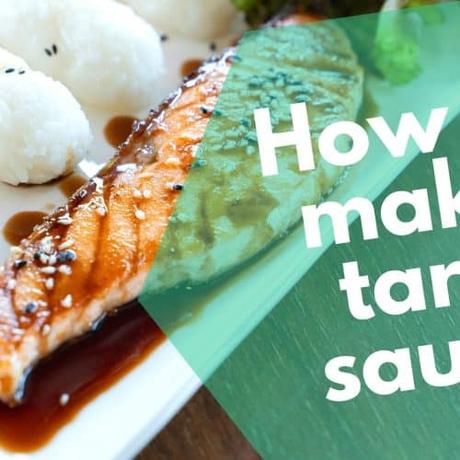If you like to use dipping sauces, and you love Japanese cuisine, then tare sauce is the way to go!
Tare sauce is a Japanese dipping sauce, which means you can flavor any bite of food with it. However, it can also be used for grilling foods, like yakitori and yakiniku, where it can make a good substitute for teriyaki sauce.

It can also be combined with broth and added to ramen and various soups, or it can be used to braise meat.
Every chef may make tare differently, but it typically has a soy sauce base with dashi or vinegar added for flavor. Soy sauce, mirin, and oyster sauce also fall under the tare sauce umbrella.
This article will review tare sauce offering recipes, uses, the best brands, and just about anything else you’d ever want to know about this wonderful condiment!
But first, check out this video by Ramen Culture on how they make tare sauce:
Good tare sauce recipes to try

Ramen tare sauce recipe
As stated earlier, tare sauce can be prepared in a number of ways. Here's a ramen tare recipe that produces great results! Course SauceCuisine JapaneseKeyword Sauce Cook Time 25 minutesTotal Time 25 minutes Servings 4 servings Author Joost Nusselder Cost $1Ingredients
- ½ cup chicken or vegetable broth low sodium or sodium free is best
- ¼ cup mirin
- ½ cup soy sauce
- 2 tbsp sake
- 1 tsp brown sugar
- 1 tsp rice wine vinegar
- 1 inch piece ginger peeled and smashed
- 1 clove garlic peeled and smashed
- 1 scallion chopped
Instructions
- Combine ingredients in a saucepan and bring to a simmer.
- Simmer tare until it reduces to ½ cup, about 25 minutes.
- Strain solids and let the sauce cool. Store in an airtight container in the refrigerator for up to 2 weeks.
Although tare is diverse, most of its recipes are pretty similar.
As the above recipe is ideal for soup, you can play around with other recipes to make a thicker consistency for dipping or basting or to add a certain flavor.
But in general, a broth base is used, mirin, soy sauce, and sake are added, and a variety of spices are used to produce an umami taste.
In other instances, different spices can be added to give the sauce a kick.

Japanese spicy sauce chuka tare
Here's an example of how to make Japanese spicy sauce chuka tare! Cuisine JapaneseKeyword Sauce Author Joost NusselderIngredients
- 6 tbsp soy sauce
- 6 tbsp rice vinegar
- 1 tsp red chili bean sauce or sriracha sauce
- 2 garlic cloves minced
- 1 tsp ginger root minced
- 3 green onions thinly sliced
- 2 tsp sesame oil
Instructions
- Mix all ingredients and chill.
What are the different types of tare?
Tare dipping sauces generally fall into three categories.
They are as follows:
- Shoyu: Also known as soy sauce, shoyu is used for noodles, meats, soup, and dipping.
- Shio: “Shio” means salt and it’s used to describe any salt based dipping sauce. In addition to the typical ingredients, it can also include dried fish products and blends of different salts.
- Miso: Miso is made from mashed legumes, grains, and koji, a fungus with enzymes that convert protein and starches in legumes into complex flavor compounds. While most of us are familiar with miso soup, miso can also be used to flavor ramen and other dishes.
Best brands of tare
There are several brands that manufacture tare sauce.
Here are a few that are worth checking out:
- Daisho Tare Yakinikudour: This highly rated brand is advertised as Japanese BBQ yakiniku shoyu sauce. It’s recommended as a dipping sauce for cooked meats or vegetables, but it can also be used as a marinade for barbecue. It’s a product of Japan.
- Kikkoman Sushi Sauce, Unagi Tare: Kikkoman is well known for producing some of the most delicious Japanese foods available in America, so it should come as no surprise that they’d make the list for one of the finest tare sauces. Their sauce is traditionally brewed with Kikkoman soy sauce and rice wine vinegar. It’s pre-thickened to produce an attractive appearance and provide a rich, savory flavor. It’s recommended for sushi and grilled foods.
- Ikari Yakiniku No Tare Medium Hot: If you like your tare with a bold, spicy flavor, then Ikari Yakiniku may be your brand of choice. It’s perfect for barbecuing. It also comes in mild varieties.
- Daisho Gyudon No Tare: This seasoned soy sauce is a product of Japan. It’s recommended for adding flavor to beef bowls.
- Morita Sukiyaki Warishita Tare: This tare is a product of Japan. It’s said to provide an authentic taste that makes cultural meals more enjoyable.
FAQs about tare sauce
Below, we’ll answer some questions you might have about tare sauce!
What does tare sauce taste like?
Tare’s known for adding flavor to dishes. There are 2 components that allow it to give food a distinct taste: salt and glutamic acid.
Since almost everyone’s eaten salt, there’s really no need to describe the kind of flavor it can provide.
Glutamic acid is used in many Asian foods to provide an umami taste, which can be described as rich and savory.
Monosodium glutamate (MSG) is the sodium salt of glutamic acid.
The mention of MSG might make some people pause. After all, it’s often been associated with certain serious health conditions.
However, the connection has never been proven.
How long can you keep tare?
Tare will last for 2 months if it’s kept in an airtight container in the refrigerator.
What’s tare in ramen?
Tare is the concentrated sauce used to season ramen.
What’s beef bare?
Beef tare is basically any type of beef flavored with tare sauce.
Tare sauce is often used as the main flavoring for Japanese barbecue since the meat usually isn’t flavored before it’s grilled.
Is tare sauce vegan?
Because the ingredients in tare are so varied, it’s impossible to say whether it’s vegan or not.
While it’s usually vegetarian, ingredients like honey are often added to teriyaki sauces that fall under the tare umbrella. And honey isn’t a vegan ingredient.
Is tare sauce gluten-free?
Those on a gluten-free diet don’t eat foods that contain the compound gluten. It’s often found in products such as wheat, barley, and rye.
In general, tare won’t be gluten-free because it’s almost always made with soy sauce, which contains wheat.
However, there are gluten-free soy sauces that can be used. If tare is made with these sauces, it’ll most likely be gluten-free.
However, other ingredients in the sauce must be gluten-free as well.
Is tare sauce keto?
Those on a keto diet eat healthy fats that are low in carbs and sugar.
Although tare sauce is generally low in carbs, it can contain sugary ingredients.
However, there are recipes for sugar-free teriyaki sauce and other sauces that fall under the tare sauce umbrella.
Is tare sauce healthy?
Because tare sauce can contain such a wide variety of ingredients, it’s difficult to find an appropriate answer for this question.
However, there are a few universal rules we can consider when determining whether or not tare sauce is healthy:
- It’s high in salt: The high salt content in tare sauce had been linked to health risks such as high blood pressure.
- It contains MSG: Although MSG hasn’t been proven to cause health issues, many claim it gives them headaches and stomachaches.
- It contains gluten: Most tare sauces contain gluten, which can cause health issues for those on a gluten-free diet.
However, tare sauce is also usually fat-free and low in carbs and calories.
Furthermore, even though it’s high in sodium, it has been shown to have lower sodium levels than table salt.
It’s also been shown to provide several health benefits.
For instance, some studies have shown certain tare sauces can improve digestion, reduce allergies and blood pressure, and boost the immune system. It’s even been known to have anticancer effects!
What’s the tare-ramen relation?
We know that tare can be used to flavor ramen, but did you know that the type of tare used in the ramen usually dictates the way ramen is classified?
For instance, you may see shio (salt), shoyu (soy) and miso ramen. These are all named according to the type of tare used in the ramen.
One exception is tonkotsu ramen. This type of ramen is named for the soup that’s used, not the tare.
There’s also a tonkotsu shoyu ramen, which is a reference to both the soup and the tare.
When used in ramen, tare works to add a salty flavor. But it can also bring an umami taste that has its own combination of sweetness, sourness, and spiciness.
For example, both shoyu and miso are saltym but they also each have their own distinct umami flavoring.
Keep this in mind when adding tare to ramen
When adding tare to ramen, it’s important to consider how much you should add. In general, it should be combined with the soup in a 1:10 ratio.
However, miso serves as an exception to this rule. It’s common to use more than 10% miso in soup because it isn’t as salty as other tare sauces.
Use tare sauce in your cooking
Tare sauce is the perfect way to flavor your meals. It lends a salty, umami taste that many diners find irresistible.
Which tare sauce do you like best?
